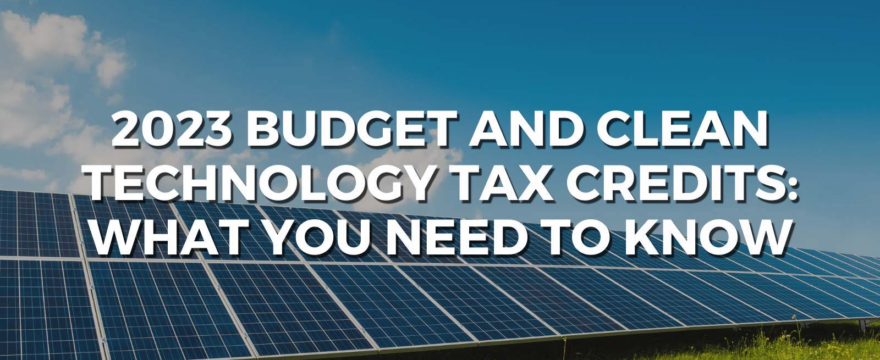
The Canadian federal government released budget 2023 at the end of March, and with it came new clean technology tax credit programs. The budget outlined an 83 billion-dollar allocation for the new clean tech programs over the next decade. These new clean technology tax credit programs align with the federal government’s commitment to clean growth objectives and help ensure Canada remains competitive in the global economy. The following is a short overview of some of the clean technology tax credit programs outlined in the 2023 federal budget. Continue reading to learn more.
Investment Tax Credits for Clean Electricity
The 2023 budget introduces a 15% tax credit for investment into clean electricity. This tax credit will be refundable, which enables pre-revenue companies to claim it. Technologies and investments that are eligible for this clean technology tax credit include the following:
- Non-emitting electricity generation technologies like wind, solar, hydro, and more
- Stationary energy storage systems that do not require fossil fuels in operation, like batteries and compressed air storage
- Abated natural gas-fired electricity generation
- Equipment for electricity transmission between the provinces and territories
Outlined with these clean electricity tax credits are the eligibility criteria. Most notably, for companies to collect their full tax credit, they must ensure that wages are paid at the median level and that apprenticeship training opportunities are created. Moreover, taxable and non-taxable entities, such as publicly owned utilities, are also eligible for the electricity tax credit.
Investment Tax Credits for Clean Technology Manufacturing
Budget 2023 also commits to investment tax credits over an eleven-year period (to begin January 1, 2024, and be eliminated by the end of 2034) to focus on investment in the manufacturing and processing of clean technologies, including the extraction and processing of critical minerals. Like the clean electricity investment tax credit, the clean tech manufacturing tax credit is also refundable but at 30% instead of 15%. Some of the eligible investments include the following:
- Investments for the extraction, processing, or recycling of critical minerals.
- The manufacturing of renewable or nuclear energy equipment and processing and recycling of nuclear fuels.
- The manufacturing of grid-scale electrical energy storage equipment like batteries, as well as the manufacturing of zero-emissions vehicles.
- The processing of particular upstream components and materials, such as batteries used in electric vehicles.
Unlike some of the other cleantech and research and development (R&D) programs offered by the federal government, such as the Scientific Research and Experimental Development (SR&ED) program, the clean technology manufacturing tax credit does not provide any labour standard eligibility provisions.
Investment Tax Credits for Clean Hydrogen
Last year’s Fall Economic Statement announced a new clean hydrogen implementation program. Now that the 2023 federal budget has been released, we have further details on this matter. The clean hydrogen tax credit is designed to compensate organizations for their investments in clean hydrogen production. The clean hydrogen credit is refundable like the other tax credits discussed above. However, unlike the clean manufacturing tax credit, minimum labour standards are required for companies to be eligible for the clean hydrogen tax credit. Moreover, the rate of the hydrogen credit is proportional to the carbon intensity of the project, with the cleanest projects being eligible for a 40% credit rate. Those projects with a carbon intensity of 4 kg or higher are ineligible for this clean hydrogen tax credit.
Support for Clean Electricity Projects
In addition to the clean electricity tax credits, the federal government has also committed to providing additional funding for the Smart Renewables and Electrification Pathways program, renewing the Smart Grid program, and generating new investments in offshore wind technology. While this is part of a 13-year initiative, it’s one of many steps in the right direction when funding clean technologies in Canada.
Avoid Gaps in Funding with Easly Advances!
These outlined cleantech tax credit initiatives offer Canadian businesses a tremendous opportunity to capitalize on their commitment to innovation and R&D in the cleantech space. In addition, these tax credits may be claimed alongside other tax incentive programs such as the Scientific Research and Experimental Development tax credit program (SR&ED). That way, your business can continue its research and development work and keep Canada innovating.
At Easly, a significant challenge we see businesses that receive government support face is accessing the funds they need in a manner conducive to the cash burn rate of a growing company. For companies pursuing an SR&ED tax credit refund, the delay between when you start spending on eligible work and receive your refund can dramatically impact your cash flow. Easly Advances enable those businesses to tap into their tax credits as they accrue, receiving regular cash advances throughout the year rather than in one lump sum.
Contact us today to learn more about SR&ED refund financing from Easly and our Capital-as-a-Service (CaaS) platform!
.png)
.png)
.png)
